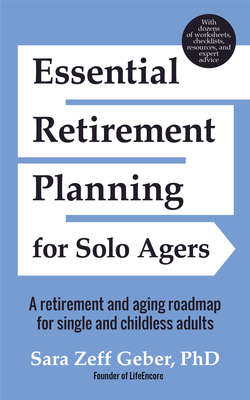Читать книгу Essential Retirement Planning for Solo Agers - Sara Geber - Страница 8
На сайте Литреса книга снята с продажи.
ОглавлениеChapter 1. Introduction
About six years ago, I started noticing that many of my friends were spending a lot of time tending to aging parents. Those who lived nearby were needed for driving, relocation, managing medications, bringing them to doctor’s appointments. Those whose parent(s) lived further away did their caregiving long distance—by managing local caregivers or by spending a lot of time on airplanes. None of my friends had thought about this ahead of time, and neither had their parents. But suddenly mom fell or a doctor called to say that dad shouldn’t drive anymore or mom’s behavior had become worrisome.
These friends of mine, these adult children were called in to help, no matter their history of closeness or off-again on-again estrangement. They showed up. Who else would do it? If there were other siblings, they usually shared the responsibility and the tasks, those living closest carrying the lion’s share, with expenses divvied up among them as best they could be.
One day, my friend Monica told me about her recent visit with her ninety-two-year-old father-in-law. She had been flying from California to upstate New York several times a year for the past three years, staying for three to four weeks at a time. During her visits she made sure he was keeping his house in order, preparing nutritious meals for himself, and paying his bills. She talked to the neighbors, went to church with him, and restocked the pantry to reassure herself and her husband that he was healthy and safe.
However, now she was concerned. On her most recent visit, Edward was displaying some troubling behaviors. He was not keeping up with his personal hygiene, and he had started wandering through the house in the middle of the night. A couple of times, thinking it was morning, he prepared breakfast for the two of them at three in the morning. Monica and her husband decided it was time to look for a residential facility and start the difficult task of preparing him for the move. Since her husband had a full-time job, they decided Monica would stay in New York for an additional month, keeping an eye on her father-in-law and managing the “project.”
When I hung up the phone and thought about what she had just told me, I asked myself, “Who will do that for us?” The answer “No one” made me gasp.
My husband and I are in our sixties and have no children. We are professionals with a lot of education and serious careers, like many of our friends—people who used to be called “DINKs” (double income, no kids). As I dug deeper, I discovered a 2005 Pew Research study which reported that 19.4 percent of the boomer generation did not have kids (almost double the percentage of child-free women in all previous generations).1 Wow!
Who will do for us what we did for our parents?
With the natural infertility rate among women around 10 percent, it seemed odd that the baby boomer rate was so high. Then it dawned on me that there were a couple of logical reasons. Number one, the baby boomers were the first generation to arrive at adolescence after the introduction of the birth control pill. The second reason is that baby boomer women were the first truly liberated women in United States history. Higher education was available, the US legal system made it a crime to discriminate on the basis of gender, and by 1980, women had begun challenging every male stronghold. A boomer woman no longer needed a man to support her. She could remain single for life or put off marriage until her thirties or forties.
Sometime in my thirties, I made a conscious choice to NOT have children. Have I ever regretted that choice? Occasionally, but only in recent years as I listen to my friends talk about their special relationships with their grandkids. On the other hand, it’s pretty hard to conjure up a relationship with grandkids when I never had kids!
If I had it to do over again, I would make the same choices. I continue to enjoy a life enriched by a challenging and ever-changing career, wonderful friends, travel, hobbies I enjoy, continuous learning, and a solid relationship with a spouse who shares my love of music, my political leanings, and most of my food preferences. We continue to fill our lives with canine companions and good friends, many of whom are also child-free baby boomers. Some of them have close ties with nieces and nephews—and as you will see in Part III, that can be very helpful in advance planning.
I wrote this book for those who live alone or, for whatever reason, have no adult children. Whether you are married/partnered or single in the second half of life (over fifty) you will not have the safety net of that immediate younger generation to count on later in life in an emergency or even an extended illness.
I do not have children, and everything I recommend in this book I have undertaken myself. These pages include many stories of others like me (whose names have been changed) from all over the country who are blazing new trails and making creative choices appropriate to their own unique circumstances. I hope my stories, research, experience, and observations encourage you to begin the planning necessary for peace of mind as you age. The journey is not long, complicated, or unnecessarily expensive. If your financial resources are slim, you may need to be creative or ask for help. Most of all, I hope this will lead you to begin a conversation with your family and friends about what you want your future to look like and the role you would like them to play.
